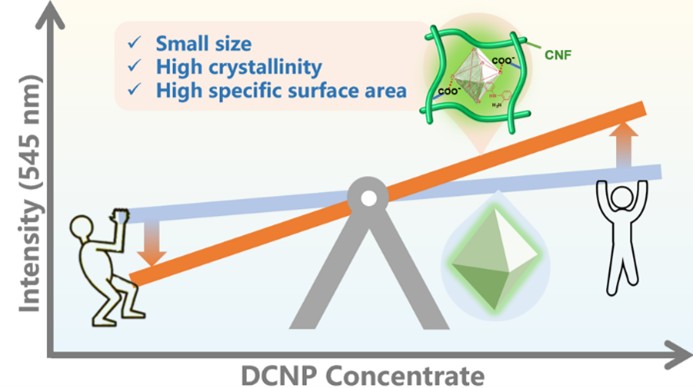
Nerve agents are highly toxic organophosphorus compounds that inhibit the enzyme acetylcholinesterase, making them potentially lethal. Developing rapid detection technologies for substances like sarin gas is crucial for national security. Metal-organic frameworks (MOFs) are considered ideal probes due to their low density and high surface area. However, modulating the size of these frameworks is essential for enhancing their sensing performance. The synthesis of nano-sized MOF nanocrystals with extensive active reaction sites remains a challenge.
To address this challenge, a research team led by Prof. DOU Xincun at the Xinjiang Technical Institute of Physics and Chemistry of the Chinese Academy of Sciences, has proposed a sustainable strategy. They utilized carboxylated cellulose nanofibrils (CNFs) to induce the in-situ growth of smaller, self-assembled UiO-66 frameworks with abundant active sites, enabling the sensitive and selective detection of nerve agent analogs. This study was published in ACS Applied Nano Materials.
The study achieved a low limit of detection (LOD) of 4.2 nM (0.685 ppb) and demonstrated robust selectivity against over 21 common substances. The sensing chip exhibited an immediate response to diethyl cyanophosphonate (DCNP) vapor in less than one second.
With an increased number of active sites, reduced background fluorescence, and superior charge transfer between the amino group and the analyte, the researchers established an efficient fluorescent platform for detecting the nerve agent analog DCNP.
In comparison to conventional hydrothermal synthesis methods for UiO-66 fluorescent probes, the smaller UiO-66 probes synthesized in this study showed a lower fluorescent background, quicker response signals, and an LOD that was reduced by eight-fold. Moreover, the incorporation of CNFs provided excellent self-assembly properties, laying the groundwork for developing portable gas detection devices for target analytes.
This strategy for synthesizing uniformly dispersed MOF materials is expected to offer new insights not only for the controllable fabrication of functional nanostructures but also for achieving high-performance chemical sensors with significant practical applications.
This research was supported by the National Natural Science Foundation of China, the China Postdoctoral Science Foundation, among others.

Structure design of UiO-66-based fluorescent probe and its schematic diagram for highly sensitive detection of DCNP (lmage by Prof. DOU's group)

86-10-68597521 (day)
86-10-68597289 (night)

52 Sanlihe Rd., Xicheng District,
Beijing, China (100864)

